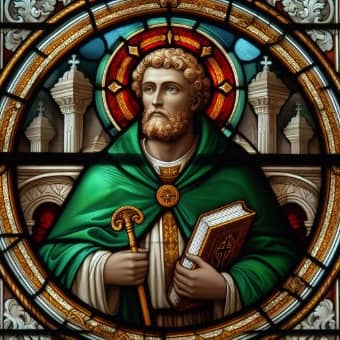Saint Kenneth, His Legacy and Modern Impact
Ever found yourself wandering through the vast tapestry of Catholic saints, only to stumble upon a name that seems to echo from ancient stones and misty shores? That’s Kenneth in Catholicism, an Irish saint whose legacy still reverberates today.
This enigmatic figure was not just another monk, but rather, a catalyst for change who dared to bring faith into the wilds of Scotland. Imagine him on those rugged landscapes – bringing light where there was darkness; creating community where isolation reigned.
In this journey together, we’ll uncover Kenneth’s life story – how he impacted Pictish tribes and established monastic communities. We’ll explore his influence on religious education programs and artistic contributions while highlighting the way he continues shaping modern parish missions.
We’re standing at history’s doorstep here… Ready to step inside?
This blog post contains affiliate links. When you click on a link on this page and make a purchase I may earn a small commission, at no additional cost to you. Thank you for your support.
The Life and Legacy of Kenneth in Catholicism
Kenneth, known for his devout faith and missionary work, left a lasting legacy within the Catholic Church.
His most notable achievement was converting King Brude Mac Maelchon to Christianity.

Early Life and Conversion Efforts
Born into Irish nobility, Kenneth embraced a religious life from an early age. The Catholic Encyclopedia – St Canice presents him as one who always sought divine guidance before embarking on any mission.
Hearing about the pagan practices among Picts in Scotland troubled him deeply. He took it upon himself to spread Christian teachings there, thus leading to his encounter with King Brude Mac Maelchon.
Inspire your faith and home décor with this stunning Sacred Heart of Jesus wall cross.
By incorporating the Sacred Heart of Jesus into our homes, we honor the legacy of saints like Saint Kenneth and enrich our own spiritual lives. May the love of Christ fill your heart and home with joy and peace.
Ministry in the Scottish Hebrides Islands
In addition to influencing key figures like King Brude Mac Maelchon, he also dedicated time for extensive ministry work amongst ordinary people residing on various islands of Scottish Hebrides.
This demonstrates how he strived not only for top-down conversion but also reached out directly at grassroots levels (Catholic Online).
“He used love as his staff,” says an old saying referring to Kenneth’s approach towards spreading Christianity.”
Persistence Despite Challenges
One might wonder why such persistent efforts were required? Well, Celtic paganism wasn’t something that could be wiped off easily; its roots ran deep into society. However, instead of being disheartened, Kenneth was more than willing to meet these challenges head-on.
His efforts bore fruit as his teachings gradually gained acceptance among the Picts and other Celtic tribes on the Scottish mainland.
Monastic Foundations by Kenneth
The influence of Kenneth in the formation of monastic establishments cannot be overstated, especially when discussing Catholicism’s historical development in Scotland and Ireland.
Aghaboe Monastery
The Birthplace of Faith
In Aghaboe, located in modern-day County Laois, Ireland, Kenneth founded a monastery that became a beacon for religious education and faith formation during his time.
This religious site not only provided a significant hub for the study of Christianity, but also acted as an impetus to spread its teachings in the area.
Kilkenny Monastery
From Humble Beginnings to Historical Landmark
Moving beyond Aghaboe’s confines led Kenneth towards Kilkenny where he established another remarkable foundation; this later evolved into what we now know as the Cathedral of Saint Canice – standing tall as testimony to this saintly legacy. The Catholic Encyclopedia – Canice
Built on what is believed to have been the site of his original church structure at Kilkenny, it has become an architectural marvel encapsulating centuries worth tales woven with faith and devotion.
Ecclesiastical Settlements Across Borders
Scotland’s Fife Region
The footprints left behind by Saint Kenneth were not confined within Irish boundaries alone; they extended far across sea waters into Scotland’s heartland – specifically Fife region around present-day city known today simply ‘Andrews’.
An important ecclesiastical settlement was established here under his guidance which blossomed over centuries into one among most revered religious sites within Scotland’s borders.
These monastic foundations by Kenneth was a critical figure in forming the spiritual atmosphere of these areas, and his substantial legacy lives on to this day, motivating both believers and non-believers.
The architectural remnants associated with his name provide tangible proof of this saint’s monumental efforts towards promoting Christianity and setting up systems for faith propagation.
Ruins Associated with Kenneth
The landscape of Scotland is dotted with ancient ruins, whispering tales of the past. Among these relics are a few linked to Saint Kenneth’s missionary work.
One notable ruin associated with him lies on Tyree Island – Kil-Chainnech. The crumbling remains echo the prayers and chants once resonating within its walls.
Kil-Chainnech isn’t just an isolated structure; it was part of a broader ecclesiastical network that included other islands in the Scottish Hebrides, such as Inchkenneth Islet.
Inchkenneth Islet
A Testament to Saintly Presence
Inchkenneth islet holds another significant site tied to Kenneth’s mission efforts. Though much smaller than Tyree Island, this place was instrumental during his time preaching Christianity in Scotland. Historic Environment Scotland suggests that this chapel might have been built by or for him due to historical associations.
This small island’s religious significance outshines its size because faith doesn’t require vast lands but devoted hearts. These locations serve as quiet reminders of his humble yet impactful service.
A Deeper Look into Kil-Chainnech Ruins
The presence of these structures validates historical records mentioning Kenneth’s journey across various parts like Picts’ territory and further north towards Scottish mainland. At places like Kil-chainnech ruins Megalithic Portal UK, we find more concrete evidence of his work.
The Kil-Chainnech ruins, despite their decayed state, stand as a testament to Kenneth’s perseverance and dedication in spreading the Gospel during an era of spiritual turmoil. His influence was such that it still lingers on these ancient stones.
Even though time may overlook these sites, they still serve as enduring reminders. They echo the foundations of Catholicism laid down by missionaries like Saint Kenneth.
The Cathedral of St Canice – A Testament to Saintly Legacy
Among the numerous symbols of Catholic faith, one stands out in Kilkenny: The Cathedral of Canice. Believed to be built on the site of Kenneth’s original church, this structure speaks volumes about his influence.
A Historical Gem
Intriguingly nestled within Ireland’s historic cityscape is a beacon from the past—the Cathedral of Canice. This towering edifice isn’t just another beautiful piece in Ireland’s architectural collection; it holds a deeper connection with history and spirituality that few can rival.
As you tread its ancient halls, whispers from centuries past fill your senses—each stone bearing witness to a bygone era where saintly men like Kenneth worked tirelessly for their faith. It’s hard not to feel an intimate connection with those who have worshipped here before us as you gaze upon age-old religious relics adorning every corner.
Built Upon Sacred Grounds
Situated atop Sandhill Hill—a spot deemed sacred long before Christianity reached Irish shores—stands this remarkable cathedral named after our beloved saint. Tradition tells us that beneath its foundations lay remnants of what was once Kenneth’s original church—an enduring testament if ever there was one.
This grand building continues carrying forward the spiritual legacy laid down by Saint Kenneth himself many centuries ago. Every brick serves as a constant reminder—not only about how far we’ve come but also about those early pioneers who dared envision such lofty dreams under challenging circumstances.
An Architectural Marvel Honoring A Spiritual Guide
Meticulously constructed over several generations starting around 1200 AD, the Cathedral of Canice mirrors Saint Kenneth’s resilience and unwavering commitment to his faith. Its grandeur reflects how influential he was in his time.
But it’s more than just its grand stature that earns admiration. Inside, you’ll find beautifully adorned chapels honoring different saints. Each one is a testament to our Catholic heritage, echoing the vital values of humility, compassion and love.
The Poetic and Scholarly Side of Kenneth
Kenneth was not just a missionary, but also an esteemed literary figure and learned individual in the Catholic faith.
Known for his commentary on the Gospels, which is referred to as Glas-Choinnigh, Kenneth combined his love for faith with a profound respect for literature and knowledge.
A Love For Literature
The Making of A Poet
Kenneth’s works were deeply intertwined with his religious beliefs. He used poetry as an expressive medium to convey spiritual teachings.
This made Kenneth stand out from other holy figures, and earned him a place as one of the early influencers in religious writing during that period.
Glas-Choinnigh
An Insight into Gospel Interpretation
The Glas-Choinnigh remains one of Kenneth’s most significant contributions to theological scholarship.
It provides deep insights into how early Christian scholars interpreted biblical texts while incorporating elements from their cultural contexts, providing readers today with valuable historical perspectives on Christianity during this time period.
This work solidified his reputation both as a theologian and literary figure within the church.
An Influential Voice Beyond His Time
Kenneth’s poetic prowess didn’t fade away after his passing; it continued influencing generations beyond his lifetime, shaping religious thought throughout history.
In fact, some have argued that without these influential writings like those found in Glas-Choinnigh,“the face we now see when looking at Christian tradition might be very different.”
By shedding light on the Gospels in his own unique way, Kenneth helped lay a foundation for future theologians and religious scholars to build upon.
Celebrating Saint Kenneth Today
Modern veneration of Kenneth offers a unique blend of ancient tradition and contemporary relevance. The saint’s feast day, celebrated on October 11th, provides an annual opportunity for believers to reflect on his life and teachings.
The faithful engage in special rituals that include attending mass, lighting candles in honor of the saint, and participating in prayer gatherings dedicated to him. These activities serve as reminders not only of Kenneth’s spiritual contributions but also inspire us to emulate his virtues.
A key aspect involved here is the sharing of Kenneth’s story. This encourages dialogue about faith formation while providing valuable insights into early Christian history.
Conclusion
Kenneth in Catholicism is more than just an ancient name; he’s a source of inspiration and guidance, shaping our faith and communities today.
We’ve traveled through time together, discovering his role in converting the Picts, founding monastic establishments like Saint Andrews, Fife and impacting religious education programs.
The journey doesn’t end here though… Carry forward these learnings into your daily life. Reflect on them during prayer times or when you need spiritual help. And remember: Saints aren’t history – they’re companions for our own spiritual journeys!
Looking for unique Catholic gifts? Check out our gift guide!
Thank you for visiting my Moody Catholic blog. If you enjoyed reading this article please tell others by clicking on the share button in the lower right hand corner, right underneath the scroll to top arrow.
